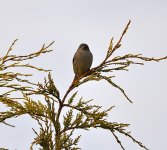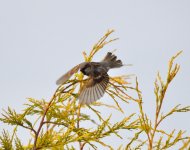When I moved here in 2002 I was stunned to see a large carpet of house sparrows through my window or patio doors even before I ever started feeding them. In the summers we always noticed the odd black headed reed one now and then in the middle of them. I thought it meant a very old sparrow. I regret I never took photos showing the vast number of them but you think its forever, it was actually years later I noticed the carpet of them was getting smaller each year. I do have to discipline myself to putting out large tumbler of good seeds about twice daily or much more in bad snow etc as hoover up is a great description. Of course I always have peanuts too. I love the noisy chattering of them in the Hawthorns because it only lasts for so long about twice daily and then total silence for you to hear the rest of the birds. Not sure but Im guessing its after feeding time they chatter as loud as possibly can and then thats it silence for hours. I love the silence after the end of the chattering. Time then for the robins, coat tits, redpolls, goldfinches or anything about to have their turn singing and thats one of the things I love about sparrows, rather accommodating birds.
Yet in the bigger picture there is no doubt that numbers are slowly decreasing and most I would see about my garden is 20 to 30 even with feeding them and yet 10 years ago it was 60 to 70 easily. I recall my Hawthorns dotted one after another by sparrows in the summer especially. I can have more lesser redpolls now than sparrows often in winter, although only small number of redpolls stay with me all summer. In Spain the sparrows will light on your table for crumbs so close its unbelievable but I find my sparrows are the last bird almost to feed close to you. If I sit quietly redpolls will time and time again be the first birds to fly to a feeder very close to me, then coal tits, goldfinches, chaffinches, robin, collared dove in that order and sparrows last always and first to go if you move by accident even. Blue tits are very wary little birds too. My mother in Omeath complained recently that she has so few sparrows now. Anyway a very interesting post indeed.






